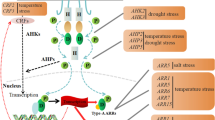Abstract
A soluble extract from pea (Pisum sativum L.) roots, when incubated with ATP and inositol 1,4,5-trisphosphate, produced an inositol tetrakisphosphate. The chromatographic properties of this inositol tetrakisphosphate, and of the products formed by its chemical degradation, identify it as inositol 1,4,5,6-tetrakisphosphate. No evidence was obtained for a 3-phosphorylation of inositol 1,4,5-trisphosphate. The importance of these observations with respect to inositol phosphates and calcium signalling in higher plants, is discussed.
Similar content being viewed by others
Abbreviations
- HPLC:
-
high-performance liquid chromatography
- Ins(1,4,5)P3 :
-
inositol 1,4,5-trisphosphate
- InsP4 :
-
inositol tetrakisphosphate
References
Berridge, M.J., Irvine, R.F. (1989) Inositol phosphates and cell signalling. Nature 341, 197–205
Bradford, M.M. (1976) A rapid and sensitive method for the quantitation of microgram quantities of protein utilizing the principle of protein-dye binding. Anal. Biochem. 72, 248–254
Drøbak, B.K. (1991) Plant signal perception and transduction: the role of the phosphoinositide system. Essays Biochem. 26, 27–37
Drøbak, B.K., Watkins, P.A.C., Chattaway, J.A., Roberts, K., Dawson, A.P. (1991) Metabolism of inositol(1,4,5)trisphosphate by a soluble enzyme fraction from pea (Pisum sativum) roots. Plant Physiol. 95, 412–419
Inhulsen, D., Niemeyer, R. (1978) Inosit-phosphate aus Lemna minor L. Z. Pflanzenphysiol. 88, 103–116
Irvine, R.F. (1990) “Quantal” Ca2+ release and the control of Ca2+ entry by inositol phosphates — a possible mechanism. FEBS Letts. 263, 5–9
Irvine, R.F. (1991) Inositol tetrakisphosphate as a second messenger: Confusions, contradictions and a potential resolution. Bioessays 13, 419–427
Irvine, R.F., Letcher, A.J., Lander, D.J., Downes, C.P. (1984) Inositol trisphosphates in carbachol-stimulated rat parotid glands. Biochem. J. 223, 237–243
Irvine, R.F., Letcher, A.J., Lander, D.J., Berridge, M.J. (1986) Specificity of inositol phosphate-stimulated Ca2+ mobilization from Swiss-mouse 3T3 cells. Biochem. J. 240, 301–354
Irvine, R.F. Letcher, A.J., Stephens, L.R., Musgrave, A. (1992) Inositol polyphosphate metabolism and inositol lipids in a green alga, Chlamydomonas eugametos. Biochem. J. 281, 261–266
Johannes, B., Brosnan, J.M., Sanders, D. (1991) Calcium channels and signal transduction in plant cells. Bioessays 13, 331–336
Joseph, S.K., Esch, T., Bonner, W.D. (1989) Hydrolysis of inositol phosphates by plant cell extracts. Biochem. J. 264, 851–856
Memon, A.R., Rincon, M., Boss, W.F. (1989) Inositol trisphosphate metabolism in carrot (Daucus carota) cells. Plant Physiol. 91, 477–480
Putney, J.W. Jr. (1990) Capacitative calcium entry revisited. Cell Calcium 11, 611–624
Sharps, E.S., McCarl R.L. (1982) A high-performance liquid Chromatographic method to measure 32P incorporation into phosphorylated metabolites in cultured cells. Anal. Biochem. 194, 421–424
Stephens, L.R. (1990) Preparation and separation of inositol tetrakisphosphates and inositol pentakisphosphates and the establishment of enantiomeric configurations by the use of l-iditol dehydrogenase. In: Methods in inositide research, pp. 9–30, Irvine, R.F., ed. Raven, New York
Stephens, L.R., Downes, C.P. (1990) Product-precursor relationships amongst inositol polyphosphates. Biochem. J. 265, 435–442
Stephens, L.R., Irvine, R.F. (1990) Stepwise phosphorylation of myo-inositol leading to myo-inositol hexakisphosphate. Nature 346, 580–583
Stephens, L.R., Hawkins, P.T., Carter, N., Chahwala, S.B., Morris, A.J., Whetton, A.D., Downes, C.P. (1988) l-myo-inositol 1,4,5,6-tetrakisphosphate is present in both mammalian and avian cells. Biochem. J. 249, 271–282
Author information
Authors and Affiliations
Additional information
J.A.C. gratefully acknowledges support from the Agricultural and Food Research Council, U.K., Plant Molecular Biology Initiative.
Rights and permissions
About this article
Cite this article
Chattaway, J.A., Drøbak, B.K., Watkins, P.A.C. et al. An inositol 1,4,5-trisphosphate-6-kinase activity in pea roots. Planta 187, 542–545 (1992). https://doi.org/10.1007/BF00199975
Received:
Accepted:
Issue Date:
DOI: https://doi.org/10.1007/BF00199975




